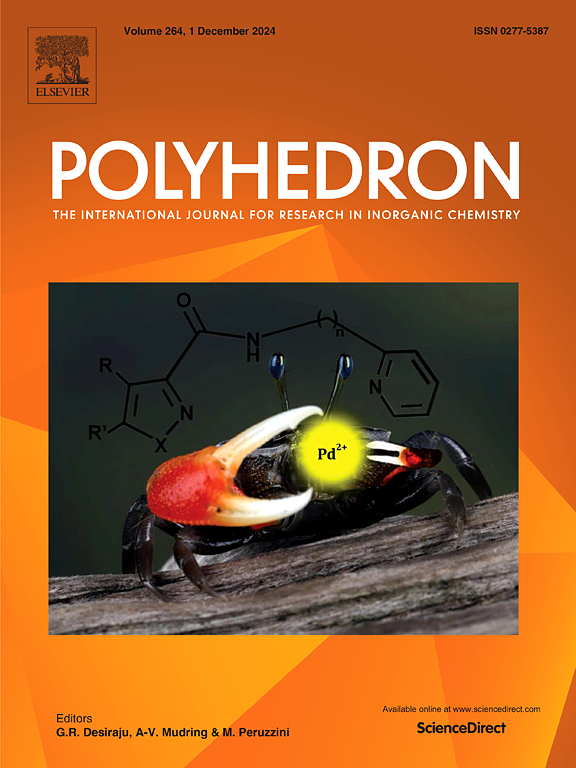Two new d10-based transition metal coordination polymers used for antibiotic degradation
IF 2.4
3区 化学
Q2 CHEMISTRY, INORGANIC & NUCLEAR
引用次数: 0
Abstract
In this study, we synthesized two new coordination polymers (CPs), [Cd2(bbpy)(L)2(DMF)2]n (1) and [Zn2(bbpy)(L)2(DMF)2]n (2) ((bbpy = 3,5-bis(benzoimidazo-2-ly)pyridine and H2L = 4,4′-((1,2-phenylenebis(methylene) bis(oxy))dibenzoic acid)), using a solvothermal method. The optical band gaps of CP 1 and 2, determined using UV–visible spectroscopy, were 2.3 eV and 2.1 eV, respectively. Both CPs demonstrated strong photocatalytic activity for the degradation of various antibiotic pollutants under UV light, with CP 2 showing superior efficiency, particularly for metronidazole (MDZ), achieving 90.89 % degradation. The optimal photocatalytic conditions for CP 2 were a catalyst dosage of 5 mg/L, an MDZ concentration of 40 ppm, and a neutral pH. The stability and reusability of the photocatalyst were confirmed through multiple cycles of use. Radical trapping experiments identified superoxide radicals (O2̇−) as the primary active species in the photocatalytic process. The photocatalytic efficiency of CP 2 was further tested in different water sources, with degradation rates of 87.99 % in tap water, 80.49 % in river water, and 92.13 % in deionized water. The presence of inorganic anions such as Cl−, NO3−, and CO32− was also studied, with CO32− having the most significant inhibitory effect on the degradation efficiency. These results suggest that CP 2 is a promising candidate for practical wastewater treatment applications.

求助全文
约1分钟内获得全文
求助全文
来源期刊

Polyhedron
化学-晶体学
CiteScore
4.90
自引率
7.70%
发文量
515
审稿时长
2 months
期刊介绍:
Polyhedron publishes original, fundamental, experimental and theoretical work of the highest quality in all the major areas of inorganic chemistry. This includes synthetic chemistry, coordination chemistry, organometallic chemistry, bioinorganic chemistry, and solid-state and materials chemistry.
Papers should be significant pieces of work, and all new compounds must be appropriately characterized. The inclusion of single-crystal X-ray structural data is strongly encouraged, but papers reporting only the X-ray structure determination of a single compound will usually not be considered. Papers on solid-state or materials chemistry will be expected to have a significant molecular chemistry component (such as the synthesis and characterization of the molecular precursors and/or a systematic study of the use of different precursors or reaction conditions) or demonstrate a cutting-edge application (for example inorganic materials for energy applications). Papers dealing only with stability constants are not considered.
 求助内容:
求助内容: 应助结果提醒方式:
应助结果提醒方式:


